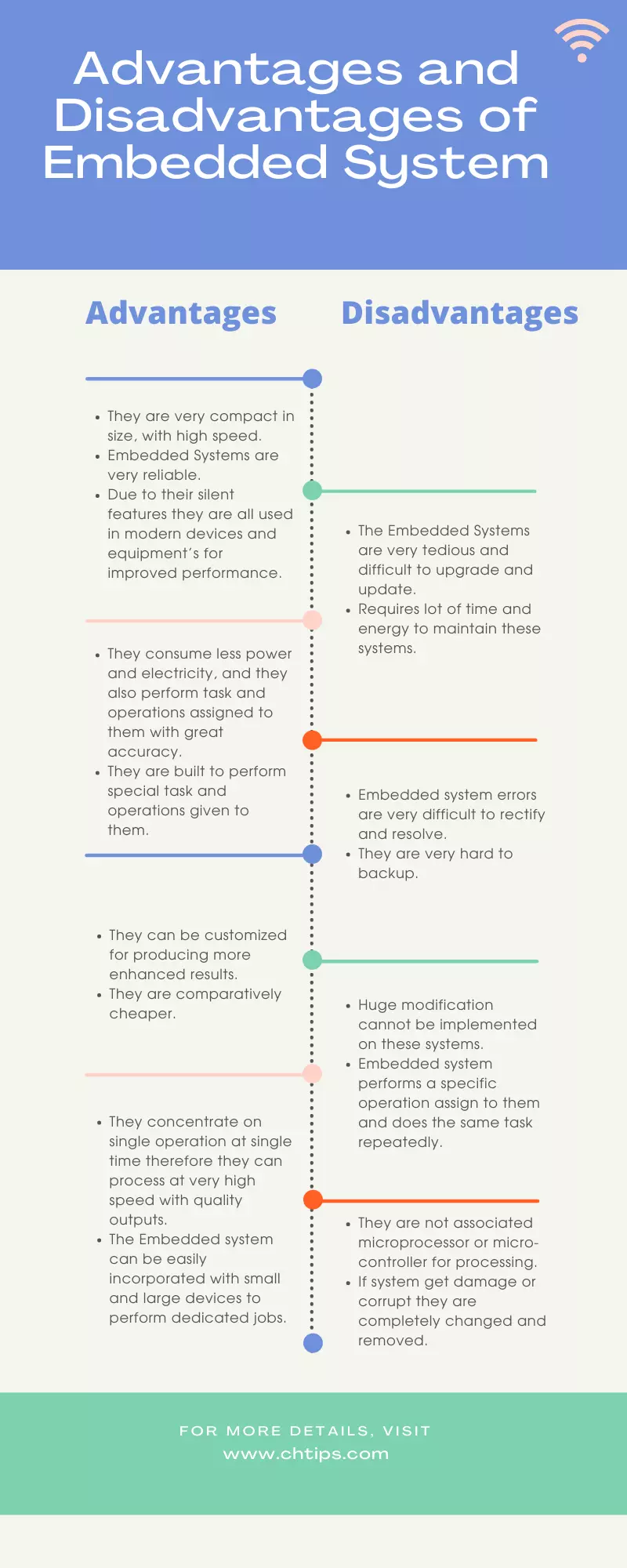In today’s post, we are going to learn and discuss what are the Advantages and Disadvantages of Embedded Systems | Benefits and Drawbacks of Embedded Systems with illustrative images, meaning, definitions, and examples.
The Embedded System is also called an Integrated System.
An Embedded system is a combination of both hardware and software.
These devices which are equipped with embedded systems are smart and efficient machines
The devices may be a smartphone, smartwatches, smart home devices, medical equipment, security alarms, products, etc.
The advancement in machine learning and artificial intelligence is playing an important role in enhancing and updating the performance of embedded system-enabled devices.
The embedded systems are also known as Firmware.
What is Embedded System and its Type?
As discussed before the embedded system is a combination of both software and hardware which are embedded into the system to perform a specific and special task.
The embedded system is a computer hardware system where software is incorporated into them.
They can be an independent or standalone system or a part of a huge system.
The Embedded system is associated with a microcontroller and microprocessor which are designed and developed for performing, implementing, and executing specific tasks.
The major benefit of an embedded system is that it can be designed, developed, and programmed to derive desired results and outputs according to the needs and requirements.
The Embedded systems are also called “Integrated Systems”.
These systems are used in our daily and routine life like smartphones, washing machines, DVD players, printers, modern instruments, etc.
Advantages and Disadvantages of Embedded Systems

Benefits and Advantages of Embedded Systems
- They are very compact in size, with high speed.
- Embedded Systems are very reliable.
- They consume less power and electricity, and they also perform tasks and operations assigned to them with great accuracy.
- They are built to perform special tasks and operations given to them.
- They can be customized for producing more enhanced results.
- They are comparatively cheaper.
- They concentrate on a single operation at a single time therefore they can process at very high speed with quality outputs.
- The Embedded system can be easily incorporated with small and large devices to perform dedicated jobs.
- Due to their silent features, they are all used in modern devices and equipment for improved performance.
Drawbacks and Disadvantages of Embedded Systems in Points
- The Embedded Systems are very tedious and difficult to upgrade and update.
- Requires a lot of time and energy to maintain these systems.
- Embedded system errors are very difficult to rectify and resolve.
- They are very hard to back up.
- Huge modifications cannot be implemented on these systems.
- The embedded system performs a specific operation assigned to them and does the same task repeatedly.
- They are not associated with microprocessors or microcontrollers for processing.
- If the system gets damaged or corrupted they are completely changed and removed.
Characteristics of Embedded System
- Embedded systems are embedded with hardware and software.
- They are built to produce and implement certain specific tasks or Jobs.
- They are incorporated with microprocessors or microcontrollers.
- Can deliver tasks and jobs at particular times without any human intervention.
- They can work in real-time.
- They are compact in size and therefore easy to use as their user interface is quite simple to interact with.
- They concentrate on a single task and operation at a given time.
Examples of Embedded Systems
- Automobiles
- Mobile Phones
- Industrial Equipment’s
- Medical Instruments
- Electronic equipment and Devices like washing machines and Owen.
- Security Peripherals and devices
- Fire alarms.
Related Articles
- 20 Advantages and Disadvantages of Mobile Phones
- Characteristics of Fourth Generations of Computer
- Functions of Primary Memory in a Computer
- Different Types of Plotters
- Advantages and Disadvantages of Microcontroller
- Advantages and Disadvantages of Magnetic Disk
- Advantages and Disadvantages of Optical Disk
- Advantages and Disadvantages of Microprocessor
- 20 Advantages and Disadvantages of Mobile Phones
- Advantages and Disadvantages of CRT Monitors
- Advantages and Disadvantages of CCTV Cameras
- Advantages and Disadvantages of Blu-Ray Disk
- Advantages and Disadvantages of Fifth Generations of Computer System
- Advantages and Disadvantages of Bluetooth
- Advantages and Disadvantages of Grid Computing
- Advantages and Disadvantages of SATA
- Advantages and Disadvantages of Speakers
- Advantages and Disadvantages of IGBT
- Advantages and Disadvantages of ATM
- Characteristics and Features of Fifth Generation Computer
- What is Computer Coding System
- Learn Computer Fundamentals
- Computer Basic Tutorials
Types of Embedded Systems
The embedded systems are divided into four types with respect to their performance and requirements
- Stand-Alone Embedded Systems
- Real-Time Embedded Systems
- Networked Embedded Systems
- Mobile Embedded Systems
1. Stand-Alone Embedded System
The Stand-Alone Embedded Systems are capable of performing tasks and operations on their own they receive analog signals from input devices and produce digital signals after processing.
They are well-equipped to handle, calculate and transfer data and information.
Examples of Embedded Systems are DVD Players, Digital Cameras, Washing machines, and Digital Owen.
2. Real-Time Embedded Systems
Real-time embedded systems are used for performing specific and special tasks at a given time.
These systems follow every instruction and process them accordingly at that specific time.
These systems are designed, developed, and programmed to produce output in real time with great accuracy and strict deadlines.
Real-time embedded systems can be divided into two types.
- Soft real-time embedded system
- Hard real-time embedded system
3. Networked Embedded Systems
The Network Embedded Systems are connected with the networks like LAN, and WAN called embedded system applications.
4. Mobile Embedded Systems
The Mobile Embedded System is used in Portable Embedded Devices like mobile phones, digital cameras, MP3 Players, etc.
Get In Touch
I have also written and compiled some articles on computers and telecommunications, and please go through them.
I hope you will like reading it.
I hope that all the questions and queries related to the Advantages and Disadvantages of Embedded System | Benefits and Drawbacks of Embedded System have been answered here.
If you have any questions related to the Pros and Cons of embedded systems.
Don’t hesitate to contact me, and if you need to add, remove, or update anything from the article, please let me know in the comment section or via email.
I will be more than happy to update the article. I am always ready to correct myself.
I was hoping you could share this article with your friends and colleagues; this motivates me to write more on related topics.
!!! Thank You !!!

Comments are closed.